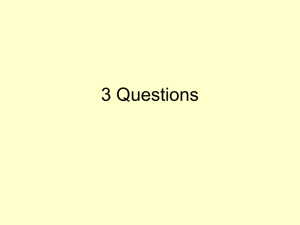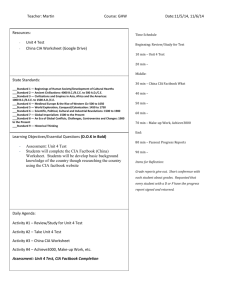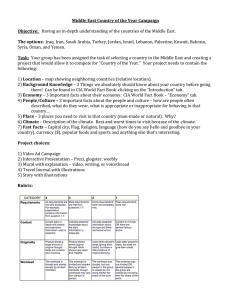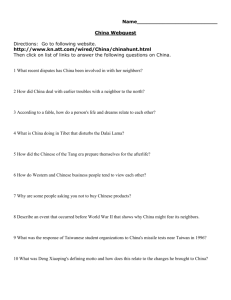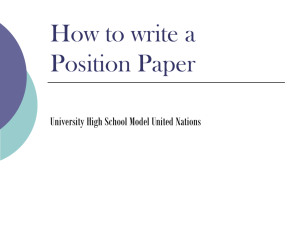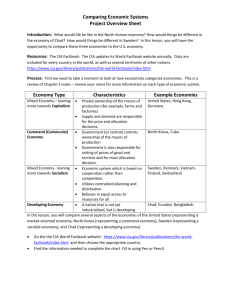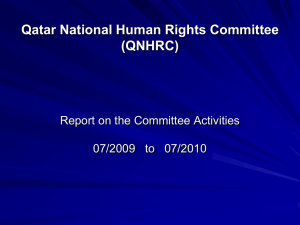World Poorest Richest Countries
advertisement
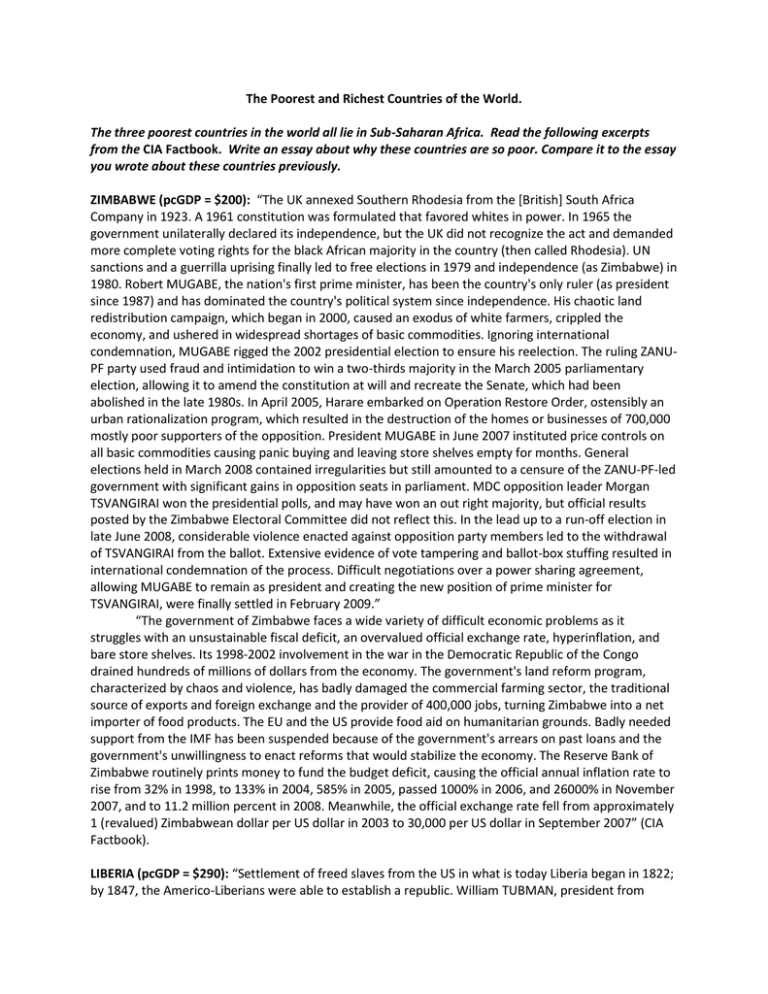
The Poorest and Richest Countries of the World. The three poorest countries in the world all lie in Sub-Saharan Africa. Read the following excerpts from the CIA Factbook. Write an essay about why these countries are so poor. Compare it to the essay you wrote about these countries previously. ZIMBABWE (pcGDP = $200): “The UK annexed Southern Rhodesia from the [British] South Africa Company in 1923. A 1961 constitution was formulated that favored whites in power. In 1965 the government unilaterally declared its independence, but the UK did not recognize the act and demanded more complete voting rights for the black African majority in the country (then called Rhodesia). UN sanctions and a guerrilla uprising finally led to free elections in 1979 and independence (as Zimbabwe) in 1980. Robert MUGABE, the nation's first prime minister, has been the country's only ruler (as president since 1987) and has dominated the country's political system since independence. His chaotic land redistribution campaign, which began in 2000, caused an exodus of white farmers, crippled the economy, and ushered in widespread shortages of basic commodities. Ignoring international condemnation, MUGABE rigged the 2002 presidential election to ensure his reelection. The ruling ZANUPF party used fraud and intimidation to win a two-thirds majority in the March 2005 parliamentary election, allowing it to amend the constitution at will and recreate the Senate, which had been abolished in the late 1980s. In April 2005, Harare embarked on Operation Restore Order, ostensibly an urban rationalization program, which resulted in the destruction of the homes or businesses of 700,000 mostly poor supporters of the opposition. President MUGABE in June 2007 instituted price controls on all basic commodities causing panic buying and leaving store shelves empty for months. General elections held in March 2008 contained irregularities but still amounted to a censure of the ZANU-PF-led government with significant gains in opposition seats in parliament. MDC opposition leader Morgan TSVANGIRAI won the presidential polls, and may have won an out right majority, but official results posted by the Zimbabwe Electoral Committee did not reflect this. In the lead up to a run-off election in late June 2008, considerable violence enacted against opposition party members led to the withdrawal of TSVANGIRAI from the ballot. Extensive evidence of vote tampering and ballot-box stuffing resulted in international condemnation of the process. Difficult negotiations over a power sharing agreement, allowing MUGABE to remain as president and creating the new position of prime minister for TSVANGIRAI, were finally settled in February 2009.” “The government of Zimbabwe faces a wide variety of difficult economic problems as it struggles with an unsustainable fiscal deficit, an overvalued official exchange rate, hyperinflation, and bare store shelves. Its 1998-2002 involvement in the war in the Democratic Republic of the Congo drained hundreds of millions of dollars from the economy. The government's land reform program, characterized by chaos and violence, has badly damaged the commercial farming sector, the traditional source of exports and foreign exchange and the provider of 400,000 jobs, turning Zimbabwe into a net importer of food products. The EU and the US provide food aid on humanitarian grounds. Badly needed support from the IMF has been suspended because of the government's arrears on past loans and the government's unwillingness to enact reforms that would stabilize the economy. The Reserve Bank of Zimbabwe routinely prints money to fund the budget deficit, causing the official annual inflation rate to rise from 32% in 1998, to 133% in 2004, 585% in 2005, passed 1000% in 2006, and 26000% in November 2007, and to 11.2 million percent in 2008. Meanwhile, the official exchange rate fell from approximately 1 (revalued) Zimbabwean dollar per US dollar in 2003 to 30,000 per US dollar in September 2007” (CIA Factbook). LIBERIA (pcGDP = $290): “Settlement of freed slaves from the US in what is today Liberia began in 1822; by 1847, the Americo-Liberians were able to establish a republic. William TUBMAN, president from 1944-71, did much to promote foreign investment and to bridge the economic, social, and political gaps between the descendents of the original settlers and the inhabitants of the interior. In 1980, a military coup led by Samuel DOE ushered in a decade of authoritarian rule. In December 1989, Charles TAYLOR launched a rebellion against DOE's regime that led to a prolonged civil war in which DOE himself was killed. A period of relative peace in 1997 allowed for elections that brought TAYLOR to power, but major fighting resumed in 2000. An August 2003 peace agreement ended the war and prompted the resignation of former president Charles TAYLOR, who faces war crimes charges in The Hague related to his involvement in Sierra Leone's civil war. After two years of rule by a transitional government, democratic elections in late 2005 brought President Ellen JOHNSON SIRLEAF to power. The UN Mission in Liberia (UNMIL) maintains a strong presence throughout the country, but the security situation is still fragile and the process of rebuilding the social and economic structure of this war-torn country will take many years.” (CIA Factbook.) Major Problem: Country trying to recover from a modern history of military dictatorships and civil war. CONGO, DEMOCRATIC REPUBLIC OF (pcGDP = $290): “Established as a Belgian colony in 1908, the Republic of the Congo gained its independence in 1960, but its early years were marred by political and social instability. Col. Joseph MOBUTU seized power and declared himself president in a November 1965 coup. He subsequently changed his name - to MOBUTU Sese Seko - as well as that of the country - to Zaire. MOBUTU retained his position for 32 years through several sham elections, as well as through the use of brutal force. Ethnic strife and civil war, touched off by a massive inflow of refugees in 1994 from fighting in Rwanda and Burundi, led in May 1997 to the toppling of the MOBUTU regime by a rebellion backed by Rwanda and Uganda and fronted by Laurent KABILA. He renamed the country the Democratic Republic of the Congo (DRC), but in August 1998 his regime was itself challenged by a second insurrection again backed by Rwanda and Uganda. Troops from Angola, Chad, Namibia, Sudan, and Zimbabwe intervened to support KABILA's regime. A cease-fire was signed in July 1999 by the DRC, Congolese armed rebel groups, Angola, Namibia, Rwanda, Uganda, and Zimbabwe but sporadic fighting continued. Laurent KABILA was assassinated in January 2001 and his son, Joseph KABILA, was named head of state. In October 2002, the new president was successful in negotiating the withdrawal of Rwandan forces occupying eastern Congo; two months later, the Pretoria Accord was signed by all remaining warring parties to end the fighting and establish a government of national unity. A transitional government was set up in July 2003. Joseph KABILA as president and four vice presidents represented the former government, former rebel groups, the political opposition, and civil society. The transitional government held a successful constitutional referendum in December 2005 and elections for the presidency, National Assembly, and provincial legislatures in 2006. KABILA was inaugurated president in December 2006. The National Assembly was installed in September 2006. Its president, Vital KAMERHE, was chosen in December. Provincial assemblies were constituted in early 2007, and elected governors and national senators in January 2007.” “Civil war and government mismanagement destroyed much of Liberia's economy, especially the infrastructure in and around the capital, Monrovia. Many businesses fled the country, taking capital and expertise with them, but with the conclusion of fighting and the installation of a democraticallyelected government in 2006, some have returned. Richly endowed with water, mineral resources, forests, and a climate favorable to agriculture, Liberia had been a producer and exporter of basic products - primarily raw timber and rubber. Local manufacturing, mainly foreign owned, had been small in scope. President JOHNSON SIRLEAF, a Harvard-trained banker and administrator, has taken steps to reduce corruption, build support from international donors, and encourage private investment. Embargos on timber and diamond exports have been lifted, opening new sources of revenue for the government. The reconstruction of infrastructure and the raising of incomes in this ravaged economy will largely depend on generous financial and technical assistance from donor countries and foreign investment in key sectors, such as infrastructure and power generation” CIA Factbook). Read the following excerpts from the CIA Factbook about the three richest countries of Monsoon Asia. Write an essay summarizing the reasons for these countries’ relative prosperity. Be sure to include physical factors where appropriate. Qatar (pc GDP = $103,500): “Ruled by the al-Thani family since the mid-1800s, Qatar transformed itself from a poor British protectorate noted mainly for pearling into an independent state with significant oil and natural gas revenues. During the late 1980s and early 1990s, the Qatari economy was crippled by a continuous siphoning off of petroleum revenues by the Amir, who had ruled the country since 1972. His son, the current Amir HAMAD bin Khalifa al-Thani, overthrew him in a bloodless coup in 1995. In 2001, Qatar resolved its longstanding border disputes with both Bahrain and Saudi Arabia. As of 2007, oil and natural gas revenues had enabled Qatar to attain the second-highest per capita income in the world.” “Qatar has experienced rapid economic growth over the last several years on the back of high oil prices, and in 2008 posted its eighth consecutive budget surplus. Economic policy is focused on developing Qatar's nonassociated natural gas reserves and increasing private and foreign investment in non-energy sectors, but oil and gas still account for more than 50% of GDP, roughly 85% of export earnings, and 70% of government revenues. Oil and gas have made Qatar the second highest per-capita income country - following Liechtenstein - and one of the world's fastest growing. Proved oil reserves of 15 billion barrels should enable continued output at current levels for 37 years. Qatar's proved reserves of natural gas are nearly 26 trillion cubic meters, about 14% of the world total and third largest in the world. The drop in oil prices in late 2008 and the global financial crisis will reduce Qatar's budget surplus and may slow the pace of investment and development projects in 2009” CIA Factbook). Luxembourg (pc GDP = $64,400) “Founded in 963, Luxembourg became a grand duchy in 1815 and an independent state under the Netherlands. It lost more than half of its territory to Belgium in 1839, but gained a larger measure of autonomy. Full independence was attained in 1867. Overrun by Germany in both World Wars, it ended its neutrality in 1948 when it entered into the Benelux Customs Union and when it joined NATO the following year. In 1957, Luxembourg became one of the six founding countries of the European Economic Community (later the European Union), and in 1999 it joined the euro currency area.” “This stable, high-income economy - benefiting from its proximity to France, Belgium, and Germany - has historically featured solid growth, low inflation, and low unemployment. The industrial sector, initially dominated by steel, has become increasingly diversified to include chemicals, rubber, and other products. Growth in the financial sector, which now accounts for about 28% of GDP, has more than compensated for the decline in steel. Most banks are foreign owned and have extensive foreign dealings. Agriculture is based on small family-owned farms. The economy depends on foreign and crossborder workers for about 60% of its labor force. Although Luxembourg, like all EU members, suffered from the global economic slump in the early part of this decade, the country continues to enjoy an extraordinarily high standard of living - GDP per capita ranks third in the world, after Liechtenstein and Qatar. After two years of strong economic growth in 2006-07, turmoil in the world financial markets slowed Luxembourg's economy in 2008, but growth remained above the European average and is likely to remain so in 2009” (CIA Factbook). Norway (pc GDP = $53,690): “Two centuries of Viking raids into Europe tapered off following the adoption of Christianity by King Olav TRYGGVASON in 994. Conversion of the Norwegian kingdom occurred over the next several decades. In 1397, Norway was absorbed into a union with Denmark that lasted more than four centuries. In 1814, Norwegians resisted the cession of their country to Sweden and adopted a new constitution. Sweden then invaded Norway but agreed to let Norway keep its constitution in return for accepting the union under a Swedish king. Rising nationalism throughout the 19th century led to a 1905 referendum granting Norway independence. Although Norway remained neutral in World War I, it suffered heavy losses to its shipping. Norway proclaimed its neutrality at the outset of World War II, but was nonetheless occupied for five years by Nazi Germany (1940-45). In 1949, neutrality was abandoned and Norway became a member of NATO. Discovery of oil and gas in adjacent waters in the late 1960s boosted Norway's economic fortunes. The current focus is on containing spending on the extensive welfare system and planning for the time when petroleum reserves are depleted. In referenda held in 1972 and 1994, Norway rejected joining the EU.” “The Norwegian economy is a prosperous bastion of welfare capitalism, featuring a combination of free market activity and government intervention. The government controls key areas, such as the vital petroleum sector, through large-scale state enterprises. The country is richly endowed with natural resources - petroleum, hydropower, fish, forests, and minerals - and is highly dependent on the petroleum sector, which accounts for nearly half of exports and over 30% of state revenue. Norway is the world's third-largest gas exporter; its position as an oil exporter has slipped to seventh-largest as production has begun to decline. Norway opted to stay out of the EU during a referendum in November 1994; nonetheless, as a member of the European Economic Area, it contributes sizably to the EU budget. In anticipation of eventual declines in oil and gas production, Norway saves almost all state revenue from the petroleum sector in a sovereign wealth fund. After lackluster growth of less than 1.5% in 200203, GDP growth picked up to 2.5-6.2% in 2004-07, partly due to higher oil prices. Growth fell to 2.3% in 2008 as a result of the slowing world economy and the drop in oil prices” (CIA Factbook).
